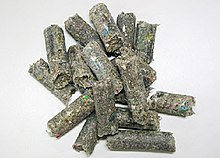
Back وقود مشتق من النفايات Arabic RDF твърдо гориво от отпадъци Bulgarian Ersatzbrennstoff German Jäätmekütus Estonian RDF (מיחזור) HE Gorivo od predobrađenog otpada Croatian 폐기물 재생 연료 Korean Refuse-derived fuel Dutch RDF-топливо Russian Паливо з відходів Ukrainian
This article needs additional citations for verification. (February 2019) |

Refuse-derived fuel (RDF) is a fuel produced from various types of waste such as municipal solid waste (MSW), industrial waste or commercial waste.
The World Business Council for Sustainable Development provides a definition:
"Selected waste and by-products with recoverable calorific value can be used as fuels in a cement kiln, replacing a portion of conventional fossil fuels, like coal, if they meet strict specifications. Sometimes they can only be used after pre-processing to provide ‘tailor-made’ fuels for the cement process".
RDF consists largely of combustible components of such waste, as non recyclable plastics (not including PVC), paper cardboard, labels, and other corrugated materials. These fractions are separated by different processing steps, such as screening, air classification, ballistic separation, separation of ferrous and non ferrous materials, glass, stones and other foreign materials and shredding into a uniform grain size, or also pelletized in order to produce a homogeneous material which can be used as substitute for fossil fuels in e.g. cement plants, lime plants, coal fired power plants or as reduction agent in steel furnaces. If documented according to CEN/TC 343 it can be labeled as solid recovered fuels (SRF).[1]
Others describe the properties, such as:
- Secondary fuels
- Substitute fuels
- “AF“ as an abbreviation for alternative fuels
- Ultimately most of the designations are only general paraphrases for alternative fuels which are either waste-derived or biomass-derived.
There is no universal exact classification or specification which is used for such materials. Even legislative authorities have not yet established any exact guidelines on the type and composition of alternative fuels. The first approaches towards classification or specification are to be found in Germany (Bundesgütegemeinschaft für Sekundärbrennstoffe) as well as at European level (European Recovered Fuel Organisation). These approaches which are initiated primarily by the producers of alternative fuels, follow a correct approach: Only through an exactly defined standardisation in the composition of such materials can both production and utilisation be uniform worldwide.
First approaches towards alternative fuel classification:
Solid recovered fuels are part of RDF in the fact that it is produced to reach a standard such as CEN/343 ANAS.[2] A comprehensive review is now available on SRF / RDF production, quality standards and thermal recovery, including statistics on European SRF quality.[3]
- ^ "The difference between RDF and SRF". Resource.co.
- ^ CEN/TC 343 - Published standards
- ^ Velis, C. A.; Longhurst, P. J.; Drew, G. H.; Smith, R.; Pollard, S. J. T. (November 30, 2010). "Production and Quality Assurance of Solid Recovered Fuels Using Mechanical—Biological Treatment (MBT) of Waste: A Comprehensive Assessment". Critical Reviews in Environmental Science and Technology. 40 (12): 979–1105. Bibcode:2010CREST..40..979V. doi:10.1080/10643380802586980. hdl:1826/6847. S2CID 110958033 – via CrossRef.
© MMXXIII Rich X Search. We shall prevail. All rights reserved. Rich X Search